The parish of Escrick is situated in what was once the wapentake of the Ouse and Derwent, part of the historical East Riding of Yorkshire (see maps in Introduction). Before the 1832 parish boundary changes it included the sub-parishes and localities of Deighton and Deighton Hall.
Before the Conquest Escrick was held by Morcar, who was defeated by the Norwegians in 1066 and rebelled repeatedly against William I. By 1086 the ownership of Escrick had been awarded to Count Alan of Brittany, along with vast estates in the north of England which acted as a buffer against the Scots. In about 1100 ownership passed to St. Mary’s Abbey in York, and later that century the abbey granted its holdings to Picot and Roger de Lascelles, members of the family that had been the abbey’s tenant in Escrick. A later Roger Lascelles was holding the manor of Escrick at his death in about 1300 and, without a male heir, it was finally inherited by Ralph, the son of one of his four daughters, who took the name Ralph de Lascelles. The Lascelles family retained the estate until the mid 15th century, when Margaret the widow of yet another Roger Lascelles married as her second husband James Pickering. Margaret’s grandson Sir Christopher Pickering was succeeded in the early 16th century by his only daughter and heir Anne, who married Sir Henry Knyvett. Thereafter the Knyvetts held the manor, and in 1607 Sir Thomas Knyvett was created Baron Knyvett of Escrick. He was succeeded by his brother Sir Henry Knyvett, whose daughter and coheir Catherine married as her second husband Thomas Howard, earl of Suffolk, in about 1583. Their son Edward was created Baron Howard of Escrick in 1628 but, heavily in debt, it was he who sold Escrick in 1668 to Sir Henry Thompson. Sir Henry was a wine merchant in York, though the family seat was in Humbleton in Holderness, and a number of his family members became MPs for neighbouring Hedon.
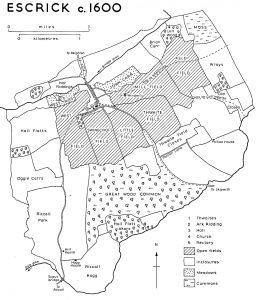
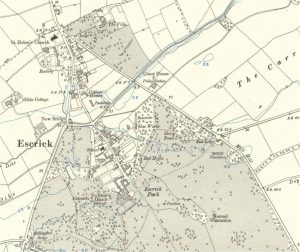
Sir Henry Thompson had been buying land in Escrick since 1666, no doubt with a view to spending his later years there. At the time the road from York divided at Escrick, one branch leading south-westwards to Riccall, the other south-eastwards to Skipwith. The village lay on this fork, its main buildings forming a reversed L, made up of 60 to 80 houses in about 1600, with the hall, church, and rectory near its centre. Sir Henry moved from York to Escrick, leaving his brother behind as his link to the outside world, and built a carriage way between the two places in 1672 for ease of access. It was his son Henry who started the transformation that would be wrought on Escrick by the Thompson family by rebuilding the hall between 1680 and 1690. The resulting house was an elegant, symmetrical house with two storeys and attic windows, a central door and portico, with evenly spaced and sized windows. Henry’s son Beilby died in 1750 and it was his wife Dame Sarah who took over the running of the estate during the minority their son, also Beilby. She bought more land in the area and had a third storey added to the hall, but it was the second Beilby who would completely remodel the village of Escrick. In 1781 he secured an Act of Parliament to demolish the church and the rectory. The act was granted on the grounds that the church was in decay and was “inconvenient for many of the parishioners”, and with the proviso that he erect a new one at his own expense. The church and the rectory were removed and rebuilt half a mile north of the village and, following the demolition of the houses that surrounded the original sites that Beilby acquired over the years, the way was open for Escrick Hall to stand alone in a large landscaped park. By the time of his death in 1799 three quarters of the village had been relocated. He left no children and the succession fell to his brother Richard, then to their sister Jane’s son. Jane was married to Sir Robert Lawley and a condition of inheritance was that their son change his surname to Thompson, thus becoming Paul Beilby Lawley Thompson. He became the first Baron Wenlock (second creation) in 1839 and his wife Caroline Neville became the first Lady Wenlock. The hall and park at Escrick continued to evolve and expand under the Wenlocks. The reversed L angle was obliterated and the main street made into a cul-de-sac, new roads were laid out to bypass the village and link up with the roads to Skipwith and Riccall, which were removed further away from the hall. When the third Baron Wenlock died in 1912, the estate passed to his daughter Irene, who in 1920 married C.G. Forbes Adam. The estate is still held by the Forbes Adam family, though the hall now houses Queen Margaret’s School for Girls and the grounds are now operated as a holiday and pleasure park.
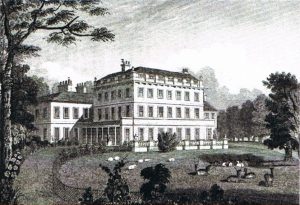 | 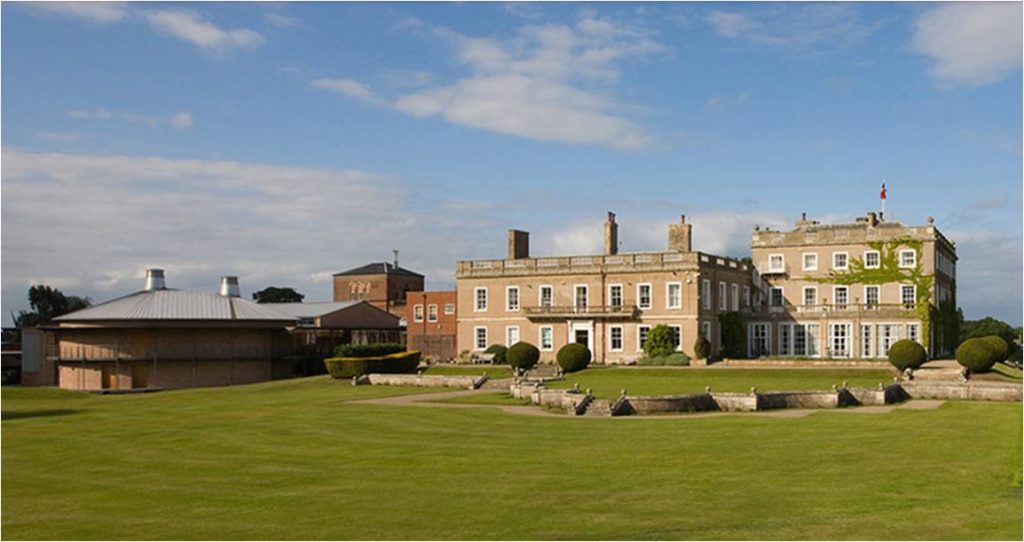 | 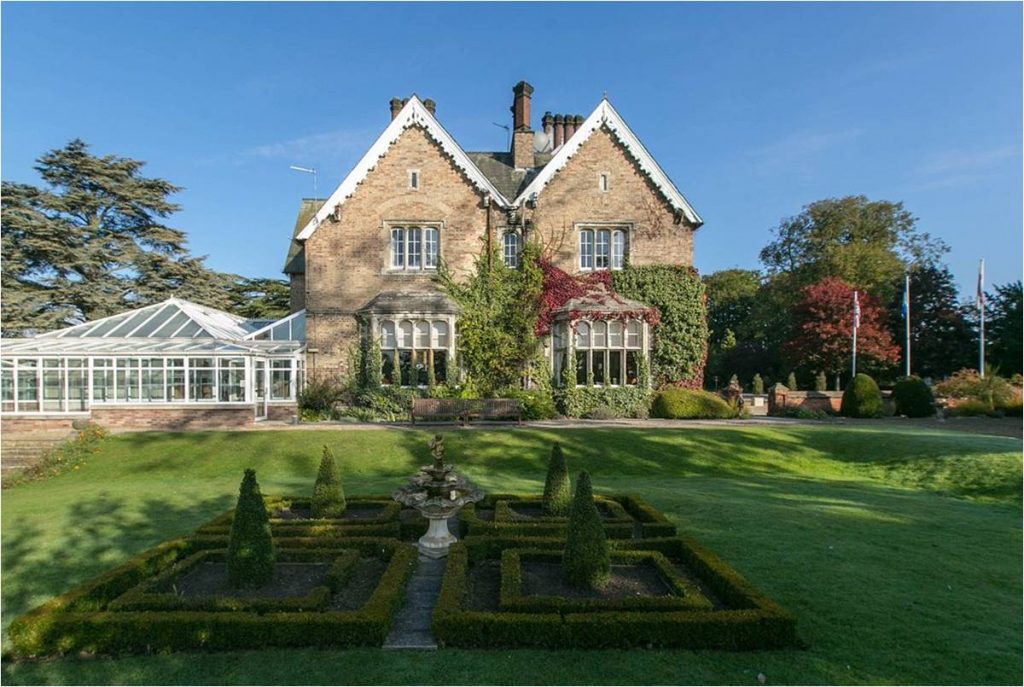 |
Archaeological evidence suggests there has been a church at Escrick since the mid 1100s, but the first mention of it was in 1252. Little is known about this old church, but there are abundant records of the Georgian church that was built to replace it. This new church was designed in the Classical style, consecrated in 1783 but was to last just over 70 years, as it in turn was replaced by a Gothic church which was consecrated in 1857 and is now a Grade II* listed building. It was gutted by fire in 1923, but was fully restored and reopened in 1925. The fire destroyed the wooden furnishings and the communion table and damaged the effigy of Caroline, Lady Wenlock, though the font and the baptistery survived. The latter was built by the Wenlocks over the family vault and contains wall-mounted memorials to them which look down on the effigy of a medieval knight, thought to be Roger de Lascelles (died c1300), one of a handful of artefacts remaining from the old church. The rectory that was demolished at the same time as the medieval church was rebuilt next to the new church and today houses the Parsonage Hotel and Spa.
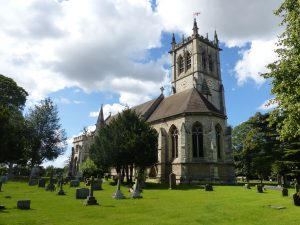 above and right: Escrick church © Robert Andrew, 2022 | 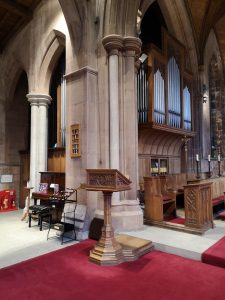 | 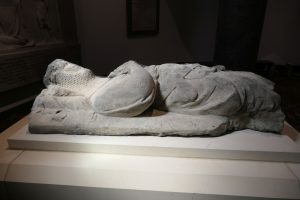 right: memorial to Beilby, 3rd Baron Wenlock | 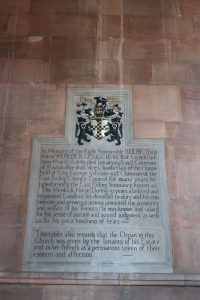 |
The Pickerings of Killington were linked to Escrick over four generations from the first half of the 15th century, through the marriage of James Pickering and Margaret Lascelles, until the Pickering name disappeared towards the end of the 16th century for want of a male heir (see above). The village devolved to their successors the Knevetts and through them to the Howards, and a quitclaim of 1668 recites a mortgage of the premises by Henry Murray (one of Lord Edward Howard’s creditors) to, among others, “Sir Henry Pickering alias Newton” of the fifth generation of the Puckerings of Flamborough. This suggests a link between the two Pickering families.
Sources:
https://www.genuki.org.uk/big/eng/YKS/ERY/Escrick
https://en.wikipedia.org/wiki/Escrick
https://opendomesday.org/place/SE6342/escrick
Victoria History of the County of York, East Riding, vol. 3, pp. 17-28: https://www.british-history.ac.uk/vch/yorks/east/vol3/pp17-28
Papers of the Forbes-Adam, Thompson, Lawley Family of Escrick: http://catalogue.hullhistorycentre.org.uk/files/u-ddfa.pdf
Escrick: a village history, J.P.G. Taylor
St Helen’s Church Escrick (guidebook)
Escrick Heritage Newsletter: https://www.escrickheritage.org/monthly-newsletter
Church of St Helen: https://historicengland.org.uk/listing/the-list/list-entry/1167966?section=official-list-entry
